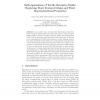Free Online Productivity Tools
i2Speak
i2Symbol
i2OCR
iTex2Img
iWeb2Print
iWeb2Shot
i2Type
iPdf2Split
iPdf2Merge
i2Bopomofo
i2Arabic
i2Style
i2Image
i2PDF
iLatex2Rtf
Sci2ools
WSOM
2009
Springer
2009
Springer
Self-Organization of Tactile Receptive Fields: Exploring Their Textural Origin and Their Representational Properties
In our earlier work, we found that feature space induced by tactile receptive fields (TRFs) are better than that by visual receptive fields (VRFs) in texture boundary detection tasks. This suggests that TRFs could be intimately associated with texture-like input. In this paper, we investigate how TRFs can develop in a cortical learning context. Our main hypothesis is that TRFs can be self-organized using the same cortical development mechanism found in the visual cortex, simply by exposing it to texture-like inputs (as opposed to natural-scene-like inputs). To test our hypothesis, we used the LISSOM model of visual cortical development. Our main results show that texture-like inputs lead to the self-organization of TRFs while natural-scene-like inputs lead to VRFs. These results suggest that TRFs can better represent texture than VRFs. We further analyzed the effectiveness of TRFs in representing texture, using kernel Fisher discriminant (KFD) and the results, along with texture cla...
Artificial Intelligence | Natural-scene-like Inputs | Receptive fields | Texture-like Inputs | WSOM 2009 |
| Added | 25 May 2010 |
| Updated | 25 May 2010 |
| Type | Conference |
| Year | 2009 |
| Where | WSOM |
| Authors | Choonseog Park, Heeyoul Choi, Yoonsuck Choe |
Comments (0)

